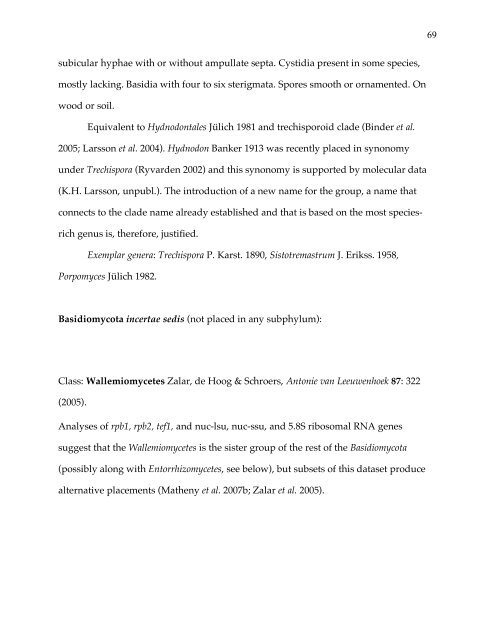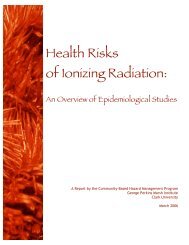Elsevier Editorial System(tm) for Mycological ... - Clark University
Elsevier Editorial System(tm) for Mycological ... - Clark University
Elsevier Editorial System(tm) for Mycological ... - Clark University
Create successful ePaper yourself
Turn your PDF publications into a flip-book with our unique Google optimized e-Paper software.
subicular hyphae with or without ampullate septa. Cystidia present in some species,<br />
mostly lacking. Basidia with four to six sterigmata. Spores smooth or ornamented. On<br />
wood or soil.<br />
Equivalent to Hydnodontales Jülich 1981 and trechisporoid clade (Binder et al.<br />
2005; Larsson et al. 2004). Hydnodon Banker 1913 was recently placed in synonomy<br />
under Trechispora (Ryvarden 2002) and this synonomy is supported by molecular data<br />
(K.H. Larsson, unpubl.). The introduction of a new name <strong>for</strong> the group, a name that<br />
connects to the clade name already established and that is based on the most species-<br />
rich genus is, there<strong>for</strong>e, justified.<br />
Exemplar genera: Trechispora P. Karst. 1890, Sistotremastrum J. Erikss. 1958,<br />
Porpomyces Jülich 1982.<br />
Basidiomycota incertae sedis (not placed in any subphylum):<br />
Class: Wallemiomycetes Zalar, de Hoog & Schroers, Antonie van Leeuwenhoek 87: 322<br />
(2005).<br />
Analyses of rpb1, rpb2, tef1, and nuc-lsu, nuc-ssu, and 5.8S ribosomal RNA genes<br />
suggest that the Wallemiomycetes is the sister group of the rest of the Basidiomycota<br />
(possibly along with Entorrhizomycetes, see below), but subsets of this dataset produce<br />
alternative placements (Matheny et al. 2007b; Zalar et al. 2005).<br />
69
















